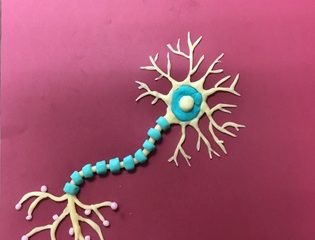
My daughter Karen wonders if she can get a little vest for Ophelia and call her a “service bird” 😉
Here is what I am reading today:
“Language and music both require rhythm; otherwise they don’t make any sense. They’re also both built from smaller units – syllables and musical beats. And the process of mastering them is remarkably similar, including precise movements, repetitive practice and focused attention. I also noticed that my musician peers were particularly good at learn”
“Learning a new language is a difficult task. It requires skills for memorizing new words, learning how to put those words together in a grammatical way, and integrating them with existing linguistic knowledge. In a new study from researchers at the Donders Institute and Max Planck Institute for Psycholinguistics, these skills were observed through brain imaging as native speakers of Dutch learned an artificial miniature language ‘Alienese’.”
“Multisite research collaborations can lead to significant discoveries, but they are also a challenge for many reasons, including logistical ones.
The National Institutes of Health (NIH) have introduced a new policy to streamline one aspect of these valuable projects: Now, multisite, NIH-funded studies conducting the same experiment are required to use only a single institutional review board (IRB) to oversee the research.”
“”I’ve been interested for quite a while in two motivations that people seem to display — one I call legacy drive and one I call leisure drive,” says Dr. Aarssen.
The maxim “work hard, play hard” — which can be traced back to at least 1827 — has long been used to express an implied connection between dedicated effort and having fun. Yet, despite its status as a trope in Western society, any statistical link between the two had never been quantified. Dr. Aarssen, along with undergraduate student Laura Crimi, conducted a survey of over 1,400 undergraduate students at Queen’s. Participants were asked to identify their age, gender, religious affiliation and cultural background. They were then asked a series of questions to determine their attraction to religion, parenthood, accomplishment or fame, and recreation.”
“Butter consumption was only weakly associated with total mortality, not associated with cardiovascular disease, and slightly inversely associated (protective) with diabetes, according to a new epidemiological study which analyzed the association of butter consumption with chronic disease and all-cause mortality. This systematic review and meta-analysis, published in PLOS ONE, was led by Tufts scientists including Laura Pimpin, Ph.D., former postdoctoral fellow at the Friedman School of Nutrition Science and Policy at Tufts in Boston, and senior author Dariush Mozaffarian, M.D., Dr.P.H., dean of the School.”
“Evolutionary biologist Professor Peter Holland and graduate student Anne Booth identified and named the genes, known as Argfx, Leutx, Dprx and Tprx, in data published by the Human Genome Project in 2002. The genes belong to the homeobox group, and it was known that other homeobox genes direct the formation of tissues and organs during development. However, when they tried to find out exactly what the newly discovered genes did, they hit a problem.”
“In a newly published study in the journal Nature Communications, two biologists from the University of Pennsylvania have developed a mathematical model of the way social networks arise in animal populations. Their model considers the likelihood that a newborn forms connections with its mother’s connections or other individuals not connected to its mother, with the assumption that an individual is more likely to connect with those connected with its mother.”
“To get a measure of the pigs’ personalities, the researchers conducted two tests: a social isolation test and a novel object test. Each pig spent three minutes in social isolation, and five minutes in a pen with a large white bucket or an orange traffic cone they had not previously encountered. Their behaviour, including vocalisations, were observed. These tests were repeated two weeks later, allowing the researchers to determine if the pigs’ responses were repeatable — the defining characteristic of personality (also known as ‘coping style’ in animals).”



10 Comments
Charlene Niku · October 25, 2016 at 8:28 pm
When I saw the title of this article, it immediately drew my attention because I am passionate about music and learning language. I think music can be a very powerful tool, not only in development, but also in therapy. I know of people who have worked with children with special needs through music therapy and have found it very successful. Knowing this, it is no surprise that music has other benefits including helping with language development and connecting people to one another. Language is an important part of communication and I found it interesting to learn how music can work to help an infant learn language. My passion for music and language makes more sense to me now because I not only played the violin for six years and sang in choir for four, but I can speak four languages pretty fluently. Reading this article has made this connection more clear to me and it is something I will keep in mind if I decide to work with children or when I have a family of my own.
savannahlestes · October 30, 2016 at 2:42 pm
The post about the connection between music learning and language learning is really interesting. As a musician, I have researched this before as it is amazing how much of your brain music playing uses. You have to see the notes, process them, plan your movements, use rhythm and timing and motor control, math and art, it uses so much! I learned that because it uses multiple parts and sides of your brain, playing music actually strengthens the corpus colosseum. Music definitely seems good for the brain and would be great for strengthening it to learn things like language!
RachelSemple · November 2, 2016 at 7:32 pm
I read the article that studied the effectiveness of the motto “work hard, play hard”. I am pleased to see that this motto that I take heart has some scientific backing. I personally believe that a balance of work and leisure is key to success in all aspects of the word random from achieving accomplishments to maintaining positive mental health. For me personally, I know that I am at my best when I remain busy with social activities and schoolwork. I give myself time to be with friends and do activities I enjoy, and this reduces the amount of time I have to get my school work done. I find that when I have all day to do 1 assignment, I usually put it off to the last minute and complete it with less focus and intensity. However, when I only have two hours to do 1 assignment, I am persistent and focused which typically results in better quality work in a more efficient time frame. In addition, I think it is important for your mental health to take time to enjoy your life and “play hard”. An improved mental state will not only make you a more satisfied with your life, but will make you less stressed when it is time to “work hard”.
RachelSemple · November 28, 2016 at 11:40 am
The article “Watching the Brain During Language Learning”, states that when an individual is learning a new language a key factor in this learning is how the new language’s grammatical structure compares to their native language’s. When an individual is learning a new language that has very different grammar structure from their native language, there is more activity in brain networks that are typically involved with the native language. Reading this immediately reminded me of Piaget’s theory of assimilation and accommodation; when learning a new language with different grammatical structure, the brain is displaying an example of accomodation. The individual is taking their preexisting knowledge (held in the brain networks typically involved with the native language) and accommodating it to develop an additional pathway of understanding grammar structure. While Piaget’s theories are focused on children, I believe that adults continue to assimilate and accommodate their schemas throughout their lives because people are constantly being exposed to new information, and this information must be organized in our brains in a similar way we did as children.
RachelSemple · December 9, 2016 at 8:15 pm
The article about the benefits of music to a child describe endless advantages to learning and being exposed to music. I believe that these findings can be easily implemented into child care programs. By including hands on musical instruments such as drums, symbols, xylophone, recorders, and simple strong instruments into child care programs children can being to develop an interest in music as well as build a foundation to understanding the world of music. Children in child care centers should also be exposed to music on a daily basis; songs can be implemented through either fun, educational, and interactive songs or calming, pre-nap time songs. These are easy ways to take advantage of the benefits that music provides.
RachelSemple · December 9, 2016 at 8:29 pm
I read the article about the correlation between pig’s personalities and their vocal patterns. While reading this article, I was thinking about the difference between communication and language. language is complex and flexible, including grammar and context, while communication is simple and inflexible. I am not sure if pigs are capable on language, but I do believe that pigs have minds and spirits and are unique from one another. Each pig is an individual, and I believe that each pig has its own unique way of speaking. Just like humans all have slightly different voices that can be recognized when you know a person well enough, pigs have specific “oinks”. For this reason, I do not see strong merit in this study, because I believe it is making many generalizations about pig’s individual noises.
gcosgrove3 · February 18, 2017 at 1:41 pm
“Little to no association between butter consumption and chronic disease or total mortality”
I thought this article was a good example about how the media can take a correlational study, draw their own conclusions, and advertise it to the public so it appears fact. Since I’ve grown up, I’ve heard that butter is not good for me. My grandma bought margin and butter was always marketed as a “forbidden food” at supermarkets and on T.V. Research, however, shows otherwise. Although there have been small correlations about the significance of heart disease and butter, the results were not significant. This article reminds me to do more research about claims I hear in the media, and seek the source, content, and accuracy of the information before I draw conclusions.
rachelcarlson · February 19, 2017 at 10:34 pm
RE: Selfie thread. (it wouldn’t let me post there for some reason!) While I do believe that some selfies are motivated by the need for approval, I do also believe that the most common and environmental factor that motivates selfie-taking has become a need to belong. Social Media, and sharing our lives through photographs, has become deeply ingrained in the fabric of our western culture. It is an important tool to relate to others, and while the intentions of all may not be entirely unselfish, I do not see any fault in the occasional selfie!
kmmenden · February 27, 2017 at 9:24 pm
I read the article on pigs grunts actually pertaining to their personality. I think we all have known that research has shown pigs to be very intelligent – even more so than dogs in some circumstances. It’s interesting to think that pigs actually have personalities and speak (grunt) with regards to their personality and environments. Having a dog, I know she has her own distinct personality from any other dog and I love her for that. It’s so cool to think that pigs also have their own personalities! When we look at humans, we definitely are more or less vocal depending on our personalities and it seems pigs are this way too. It’s also very interesting that male pigs seemed to be more influenced by environment and thus have different speech patterns than female pigs. It would be interesting to see what other research could be done on pigs and their personalities.
kayleeroe · May 9, 2017 at 11:21 pm
I read the article, “Could Early Music Training Help Babies Learn Languages?”. I thought this article was fascinating since it connected learning music to such a key part of our society- language. Knowing that musical experience, even at the early ages of nine months, can improve a human’s ability to process musical and speech rhythms is a breakthrough that could help many parents to be. After reading this article, I have learned the importance of playing music and exposing children to music to help them with their speech and processing of language. I believe this has the ability to affect many parenting styles in the future!